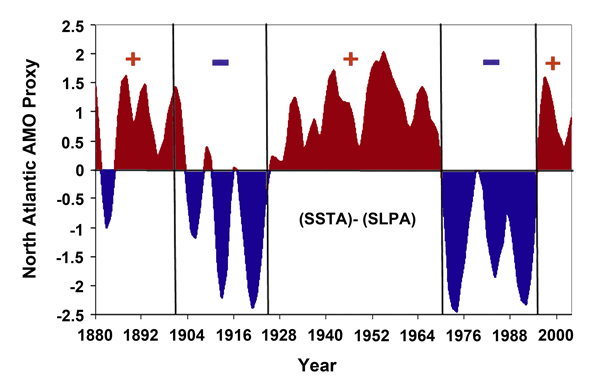Reference
Klotzbach, P.J. and Gray, W.M. 2008. Multidecadal variability in North Atlantic tropical cyclone activity. Journal of Climate 21: 3929-3935.
Background
Climate alarmists generally contend that global warming increases tropical cyclone (TC) and hurricane (H) activity, and that the past several years have provided evidence for this effect. Climate realists, on the other hand, attribute the enhanced TC and H activity of the recent past to the occurrence of the positive state of a decadal-scale cycle that leads to periodic ups and downs in TC and H numbers and intensities.
What was done
In further exploring this subject, the authors employed sea surface temperature (SST) data for the far North Atlantic (50-60°N, 50-10°W) and sea level pressure (SLP) data for the North Atlantic (0-50°N, 70-10°W) to construct an index of the Atlantic Multidecadal Oscillation (AMO), which they defined as the difference between the standardized SST and SLP anomalies (SST-SLP) for the hurricane season of June-November, and which they evaluated for the period 1878-2006, after which they compared their results (to which they applied a 1-2-3-2-1 filter) with a number of hurricane properties.
What was learned
Klotzbach and Gray's analysis revealed the existence of three positive and two negative AMO phases over the period of their study, as may be seen in the figure below.

Figure 1. North Atlantic AMO Index. Adapted from Klotzbach and Gray (2008).
In comparing annually-averaged results for TC characteristics between the positive and negative AMO phases indicated in the above graph, it can be calculated from the TC data of the authors that the positive AMO phase-to-negative AMO phase ratios of hurricane numbers, hurricane days, major hurricane numbers and major hurricane days were 1.53, 1.89, 2.00 and 2.46, respectively, over the entire period studied, while for the 20 most positive and 20 most negative AMO years the same ratios, in the same order, were 1.73, 2.41, 2.80 and 4.94.
What it means
Clearly, the state of the North Atlantic AMO is tremendously important to hurricane genesis and development; and this striking natural variability makes it impossible to determine if there is any long-term trend in the TC data that might possibly be due to 20th-century global warming.




